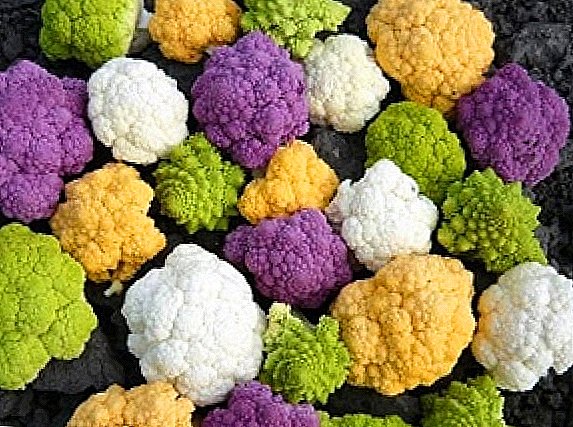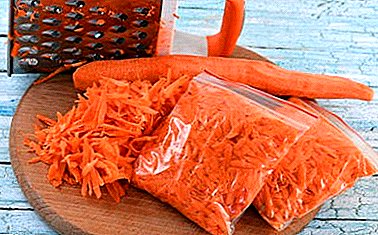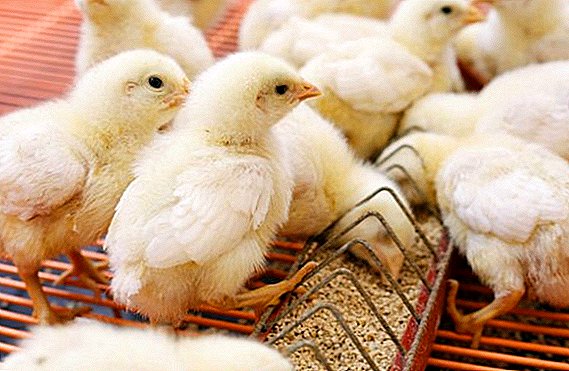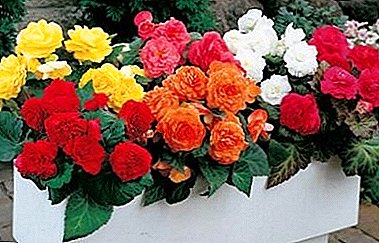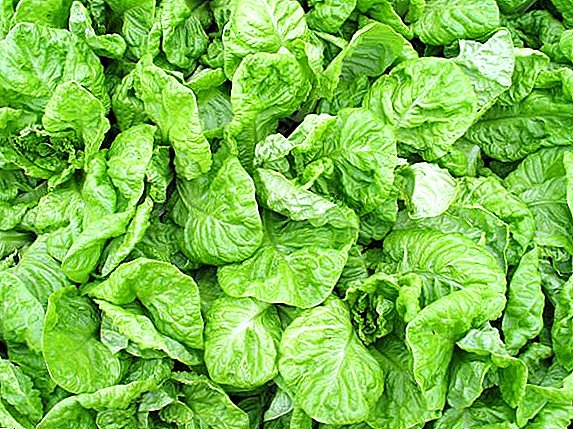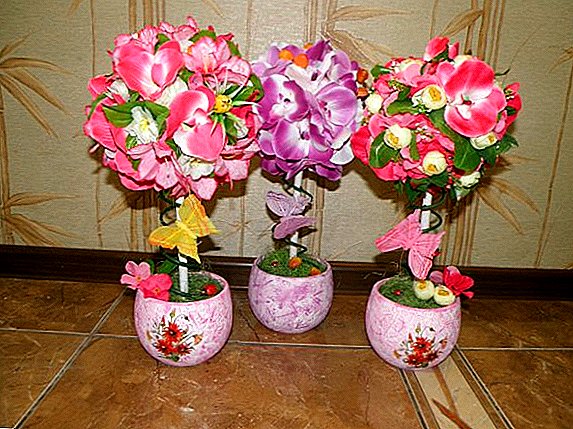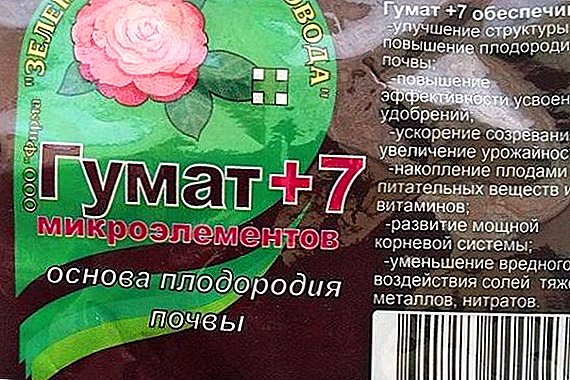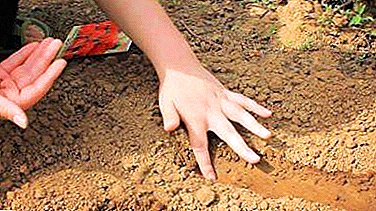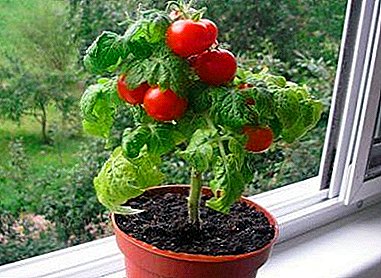
Among the varieties of tomatoes grown as indoor and balcony ornamental plants, tomatoes of the "Pinocchio" variety occupy a worthy place, along with other "dwarfs" having not only small fruits, but bush growth not exceeding 25-30 cm.
It is worth noting that this variety of tomatoes is extremely fruitful and stable, with high germination and with minimal care, giving up to one and a half pounds of juicy fruits.
Its good taste and high fructification led to widespread varieties in horticulture and cooking.
Description and characteristics of the variety
Tomatoes "Pinocchio" - is an annual plant from the family of nightshade, mid-season variety for growing houses on balconies and window sills with a growth period of 85-95 days. The maximum height of the stem is 20-35 centimeters, the plant does not require a pinching. Productivity is high, up to one and a half kilograms from one bush, on one bunch up to 10 fruits.
 Used in cooking for fresh consumption and whole-canning. High resistance to pests.
Used in cooking for fresh consumption and whole-canning. High resistance to pests.
- Fruits: flat-rounded, glossy, smooth, the size of a walnut, weight up to 25-30 grams.
- The flesh is juicy, the taste is sweet and sour. The central stalk is dense, firm, strong, well holds all bush.
- The foliage is lush, with patterned edges, dark green.
- The flowers are small, up to 1 centimeter, bright yellow. The aroma is expressed in all parts of the plant.
History of creation
This culture was brought to Europe at the beginning of the 18th century and was first grown as an ornamental pot plant. In the future, breeding specialists from South America identified genes responsible for taste in the variety, and through numerous experiments, fixed this feature in the plant. The derived hybrid culture obtained high stability in the external environment, attractive appearance and good taste characteristics.
Preparatory activities
Location, lighting, temperature, humidity
Preferably growing on the southwest, southeast side, the north side is not recommended for growing.
The plant is light-requiring, daylight should be at least eight hours a day. The air temperature for sowing seeds is 20-35 degrees, with the emergence of shoots - 15-18 degrees, for further growth - 18-22 degrees. Optimum air humidity is 40-60%It is not recommended to go beyond this range.
Capacity Selection
- Flower pots: height not more than 15-20 centimeters, volume not more than 6-7 liters, but not less than 3 liters (necessary for timely and proper development of the root system). Material - plastic, ceramics, clay, wood. Form - round, rectangular.
- Boxes: the size should not exceed 25 by 40 centimeters with a box height of no more than 20 centimeters. Material - wood, plastic, polyethylene. The shape is square or rectangular.
- Use of plastic bottles with the cut off part is allowed, because their transparency allows good regulation of soil moisture and watering.
Any container must have a pallet.
How to grow tomato seedlings at home?
Seed selection
 For planting choose seeds not older than two years of age.
For planting choose seeds not older than two years of age.
- They are lowered into a container with water so that the water level is 1-2 centimeters above the level of seeds.
- After half an hour, surfaced seeds that are empty are removed.
- After that, the seeds are treated with a weak solution of potassium permanganate for 15-20 minutes or with a prepared fungicide.
- Remove seeds with external damage and cracks.
A day before sowing, seeds are soaked in 5-6 layers of wet gauze.
Proper soil preparation
The soil should be loose and fertile, enriched with minerals, with a neutral or slightly acidic environment. The soil from beds older than 2 years is not used.
It is preferable to purchase ready soil for tomatoes, also You can prepare the soil yourself:
- take 1 part of the garden land from those plots where tomatoes did not grow before (1 bucket);
- dried;
- add 1 bucket of humus, 1 bucket of peat and 200 grams of wood ash;
- Phosphoric fertilizer is applied to the finished mixture.
Sowing
Time for sowing: the end of March or the beginning of April. For winter harvest seeds are planted in September. Seeds are planted one by one or in nests of 2-3 seeds in one cup for seedlings to a depth of no more than 1.5-2 centimeters. After sowing, the soil is watered and covered with plastic or food wrap. The optimum temperature for germination is at least 25 degrees.
Seedling care
Shoots germinate after about 4-5 days from sowingafter which the film should be removed and the seedlings transferred to a room with a temperature of 15-18 degrees, which contributes to the good development of the root system.
The optimum temperature for further plant growth is 18-22 degrees. After the shoots have 2-3 true leaves, they dive, the false leaves are removed. Watering seedlings is carried out 1 every 3-4 days, depending on soil moisture. The formation of a crust on the ground is not allowed.
Transfer
 The seedlings are planted on a permanent place no earlier than when they reach 12–13 centimeters in height (20–32 days after the emergence of seedlings). For planting choose the strongest seedlings without yellow leaves.
The seedlings are planted on a permanent place no earlier than when they reach 12–13 centimeters in height (20–32 days after the emergence of seedlings). For planting choose the strongest seedlings without yellow leaves.
Preparation for transplant:
- Seedlings carefully removed from the cups, pre-moistened soil, so as not to damage the root system.
- After extracting the seedlings, the roots are checked: the root rod should be one, strong and long, with multiple thin branches moving away from it.
After that prepare the ground. Loamy and sandy soils should not be used; it is also not recommended to use old soil on which tomatoes were previously grown. Soil can be prepared by the same technology as for sowing seeds. If only soil is taken from the beds, then mineral fertilizer is used less.
Step-by-step care instructions
Watering and fertilizer
Watering is carried out regularly as the soil dries. Acidification or crust formation should not be allowed. If the capacity for seedlings is transparent, watering is adjusted according to the appearance of the soil, making sure that mold does not appear at the edges of the container. Water for irrigation should be pre-settled for 3-5 days at room temperature.
Fertilizers are introduced only after the appearance of the fifth seedlings in the seedlings. As a top dressing use:
- ready-made mineral fertilizers ("Superphosphate", urea);
- wood ash;
- egg shells;
- Brewer's yeast.
Natural fertilizers are prepared according to the scheme of 20 grams per bush, or using mullein (1 part per 5 parts of water) at the rate of 1 liter of solution per 1 bush. After 10-14 days fertilizing is repeated with the same composition. Feed dressing is allowed during the fruit ovary. 10 days before harvesting, feeding is stopped.
Temperature
Temperature at night: the temperature should not be below 18 degrees. In the daytime, the temperature should not be below 20-22 degrees.
Trimming and Pinching
Pinching is carried out on the upper tip of the stem when it exceeds the height of 20-25 centimeters. This will allow the bush to grow more lush and give more fruit. Also pinch too large branches. It is necessary to remove excess flowers from the plant. Trimming is carried out only when the stem reaches 35 centimeters, to prevent excessive growth in height.
Props, hanging
 This variety does not need to be supported or hung. with proper pinching and trimming. The stem of the plant is strong and steady, keeps the entire bush well on itself.
This variety does not need to be supported or hung. with proper pinching and trimming. The stem of the plant is strong and steady, keeps the entire bush well on itself.
When growing a variety in greenhouse conditions or in the open field, props are carried out if the stem height exceeds 35 centimeters, with the help of wooden pegs or ladders.
Perhaps hanging for thin long pieces of cloth to the trellis. Loosening the soil is carried out after each irrigation in parallel with the removal of weeds.
Fruit picking
When the plant reaches a height of 28-35 centimeters (at 65-70 day of vegetation), fruits begin to ripen on it. At the same time the plant turns yellow and dries out gradually. From one bush collect up to one and a half kilogram a tomato when they reach a bright red color.
Additional tips and warnings
- This variety is not susceptible to the development of diseases, but can get sick with improper care. The plant is not recommended to spray, since the ingress of moisture has a detrimental effect on the foliage and causes its yellowing.
- With the natural drying of the plant, there is no need for additional activities, as the bush has a short period of life, and drying is a normal process. Manifestations: gradually yellowing and drying of foliage and branches from top to bottom.
- During the growing season it is necessary to remove weeds and loosen the soil, at the time of transplanting seedlings - removing false leaves.
- During the flowering period, they must be carefully shaken the bushes, which helps them to pollinate qualitatively.
- Ripe tomatoes should not be left on the branches - if they are removed in a timely manner, the fruiting will be abundant.
- The lack of natural lighting can cause growth retardation, deterioration of fruit taste and even the death of the plant, therefore in the winter time it is recommended to carry out additional lighting with fluorescent lamps.
Dwarf variety "Pinocchio" has a decorative appearance, high yield and rich mineral composition. The lush foliage of the plant in combination with small bright fruits allow growing the variety as a pot plant at any time of the year, and dense and strong tomatoes are suitable for whole-canning and have a memorable sweet-sour taste.


